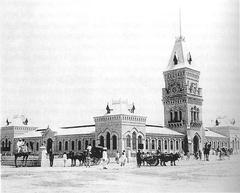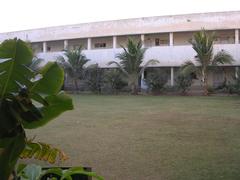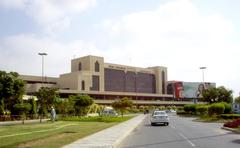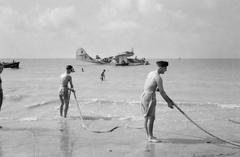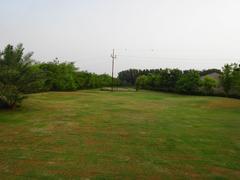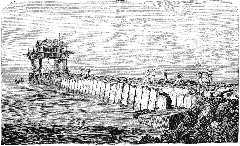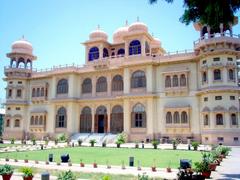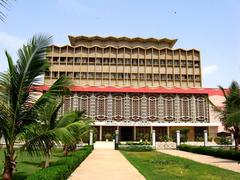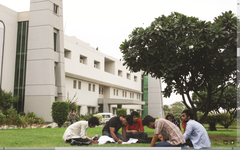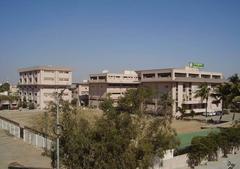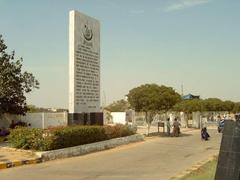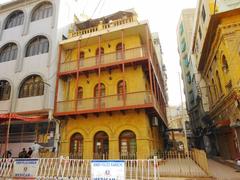Visiting Frere Hall: History, Tickets, and Tips
Date: 17/07/2024
Introduction
Frere Hall, an iconic landmark in Karachi, Pakistan, stands as a significant testament to the city’s rich colonial history and vibrant cultural life. Constructed in 1865 during the British colonial era, Frere Hall was named after Sir Henry Bartle Edward Frere, a British colonial administrator who played a pivotal role in the development of Karachi as a major port city (source). Designed by Lieutenant Colonel Clair Wilson, the building showcases the Venetian Gothic architectural style, featuring pointed arches, ribbed vaults, and flying buttresses, which highlight the grandeur and authority of the British Empire while incorporating local design elements (source). Today, Frere Hall serves as a cultural and civic center, housing a library and an art gallery, and hosting numerous cultural events and exhibitions, making it a must-visit destination for history enthusiasts and tourists alike.
Table of Contents
- [Introduction](#introductionintroduction)
- [History of Frere Hall, Karachi](#history-of-frere-hall-karachihistory-of-frere-hall-karachi)
- [Origins and Construction](#origins-and-constructionorigins-and-construction)
- [Architectural Significance](#architectural-significancearchitectural-significance)
- [Role in Colonial Karachi](#role-in-colonial-karachirole-in-colonial-karachi)
- [Post-Independence Era](#post-independence-erapost-independence-era)
- [Recent Developments](#recent-developmentsrecent-developments)
- [Visitor Information](#visitor-informationvisitor-information)
- [Visiting Hours](#visiting-hoursvisiting-hours)
- [Tickets](#ticketstickets)
- [Accessibility](#accessibilityaccessibility)
- [Travel Tips and Nearby Attractions](#travel-tips-and-nearby-attractionstravel-tips-and-nearby-attractions)
- [Special Events and Guided Tours](#special-events-and-guided-toursspecial-events-and-guided-tours)
- [Frequently Asked Questions (FAQ)](#frequently-asked-questions-faqfrequently-asked-questions-faq)
- [Conclusion](#conclusionconclusion)
History of Frere Hall, Karachi
Origins and Construction
Frere Hall, an iconic structure in Karachi, Pakistan, was constructed during the British colonial era. The building was named after Sir Henry Bartle Edward Frere, who was the Commissioner of Sindh from 1851 to 1859. Frere was instrumental in promoting economic development in the region, including the construction of infrastructure and the establishment of the Karachi Port. The hall was intended to serve as a town hall and a cultural center for the burgeoning city.
The construction of Frere Hall began in 1863 and was completed in 1865. The building was designed by Lieutenant Colonel Clair Wilson in the Venetian Gothic style, which was popular in British colonial architecture. The structure is primarily made of yellowish limestone from the nearby Gizri quarry, with red and grey sandstone trimmings. The hall’s design features pointed arches, ribbed vaults, and flying buttresses, which are characteristic of Gothic architecture. The total cost of construction was approximately Rs. 180,000, a significant sum at the time.
Architectural Significance
Frere Hall is a prime example of the Venetian Gothic architectural style, which combines elements of Gothic architecture with influences from the Italian Renaissance. The building’s façade is adorned with intricate carvings and decorative elements, including floral motifs and geometric patterns. The hall’s interior features a large central hall with a high ceiling supported by wooden beams and columns. The walls are decorated with frescoes and murals, adding to the building’s aesthetic appeal.
One of the most notable features of Frere Hall is its library, which houses a vast collection of books, manuscripts, and historical documents. The library was established in 1865 and has since become one of the most important cultural institutions in Karachi. The collection includes rare books and manuscripts, some of which date back to the 16th century. The library is a valuable resource for researchers and scholars, providing insights into the history and culture of the region.
Role in Colonial Karachi
During the British colonial period, Frere Hall served as a focal point for social and cultural activities in Karachi. The hall hosted a variety of events, including public meetings, lectures, and exhibitions. It was also a venue for musical performances and theatrical productions, attracting audiences from across the city. The building’s central location and impressive architecture made it a popular gathering place for the city’s elite.
In addition to its role as a cultural center, Frere Hall also served as a venue for political events. The hall hosted meetings of the Karachi Municipal Corporation and other civic organizations, playing a key role in the governance of the city. The building was a symbol of British authority and influence in the region, reflecting the colonial administration’s efforts to promote civic engagement and public participation.
Post-Independence Era
Following Pakistan’s independence in 1947, Frere Hall continued to serve as a cultural and civic center. The building was used for a variety of purposes, including public meetings, exhibitions, and cultural events. In the 1950s and 1960s, the hall became a popular venue for art exhibitions, showcasing the works of prominent Pakistani artists. The building’s library also continued to grow, adding new books and manuscripts to its collection.
In the 1980s, Frere Hall underwent a major renovation to restore its original architectural features and improve its facilities. The renovation project was funded by the government of Pakistan and included the restoration of the building’s façade, the repair of its roof and windows, and the installation of modern amenities. The project also included the creation of a new garden and landscaping around the building, enhancing its aesthetic appeal.
Recent Developments
In recent years, Frere Hall has continued to play a vital role in Karachi’s cultural and civic life. The building hosts a variety of events, including art exhibitions, literary festivals, and public lectures. The hall’s library remains an important resource for researchers and scholars, providing access to a vast collection of books and historical documents.
One of the most significant recent developments at Frere Hall is the restoration of its ceiling murals, which were painted by the renowned Pakistani artist Sadequain in the 1980s. The murals, which depict scenes from Pakistani history and culture, had deteriorated over time due to exposure to the elements. In 2017, a team of conservation experts began a project to restore the murals to their original condition. The project was completed in 2019, and the restored murals are now a major attraction for visitors to Frere Hall (source).
Visitor Information
Visiting Hours
Frere Hall is open to visitors from 9:00 AM to 5:00 PM, Monday through Saturday. It is closed on Sundays and public holidays.
Tickets
Entry to Frere Hall is free of charge. However, donations for the maintenance and preservation of the hall are welcome.
Accessibility
Frere Hall is accessible to visitors with disabilities. There are ramps and accessible pathways available.
Travel Tips and Nearby Attractions
When visiting Frere Hall, consider exploring nearby attractions such as the Karachi Zoo, Empress Market, and the Quaid-e-Azam House Museum. It’s also a good idea to visit during the cooler months from November to March for the best experience.
Special Events and Guided Tours
Frere Hall hosts a variety of special events throughout the year, including art exhibitions, literary festivals, and public lectures. Guided tours are available for a nominal fee. It is advisable to book these tours in advance through local tour operators or the Karachi Metropolitan Corporation’s official website.
Frequently Asked Questions (FAQ)
- What are the visiting hours for Frere Hall?
- Frere Hall is open from 9:00 AM to 5:00 PM, Monday through Saturday.
- How much does it cost to visit Frere Hall?
- The entry fee is free, but donations are welcome.
- Is Frere Hall accessible for people with disabilities?
- Yes, Frere Hall has accessible pathways and ramps.
Conclusion
In conclusion, Frere Hall remains a vital cultural and historical landmark in Karachi, offering visitors a unique glimpse into the city’s colonial past and its ongoing cultural evolution. The hall’s architectural splendor, combined with its rich historical significance and vibrant cultural activities, make it an essential stop for anyone exploring Karachi’s historical sites. With no entry fee and accessible facilities, Frere Hall is welcoming to all visitors, providing an enriching experience through its library, art gallery, and various special events. Whether you’re a history buff, an art enthusiast, or simply looking to explore one of Karachi’s most iconic structures, Frere Hall promises a memorable visit (source).

